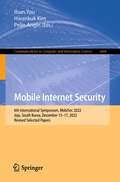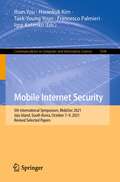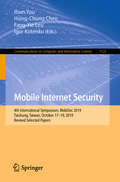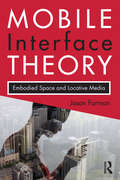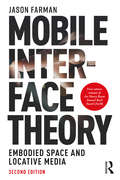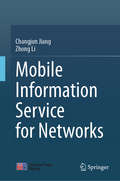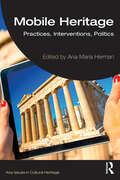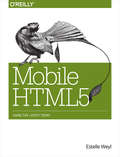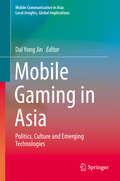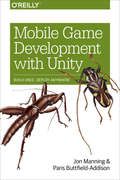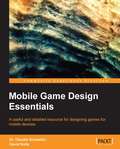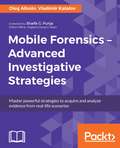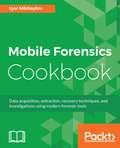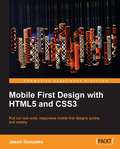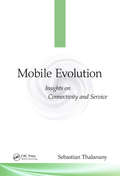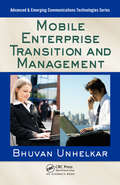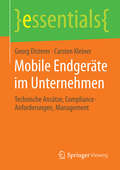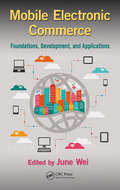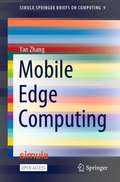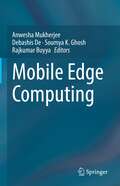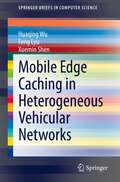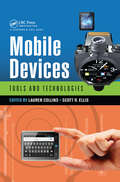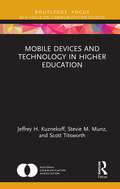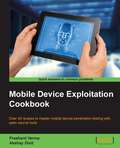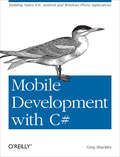- Table View
- List View
Mobile Internet Security: 6th International Symposium, MobiSec 2022, Jeju, South Korea, December 15–17, 2022, Revised Selected Papers (Communications in Computer and Information Science #1644)
by Ilsun You Hwankuk Kim Pelin AnginThis book constitutes the refereed proceedings of the 6th International Conference on Mobile Internet Security, MobiSec 2022, held in Jeju, South Korea, in December 15–17, 2022.The 24 full papers included in this book were carefully reviewed and selected from 60 submissions. They were organized in topical sections as follows: 5G advanced and 6G security; AI for security; cryptography and data security; cyber security; and IoT application and blockchain security.
Mobile Internet Security: 5th International Symposium, MobiSec 2021, Jeju Island, South Korea, October 7–9, 2021, Revised Selected Papers (Communications in Computer and Information Science #1544)
by Ilsun You Francesco Palmieri Igor Kotenko Hwankuk Kim Taek-Young YounThis book constitutes the refereed proceedings of the 5th International Symposium on Mobile Internet Security, MobiSec 2021, held in Jeju Island, Republic of Korea, in October 2021.The 28 revised full papers presented were carefully reviewed and selected from 66 submissions. The papers are organized in the topical sections: IoT and cyber security; blockchain security; digital forensic and malware analysis; 5G virtual Infrastructure, cryptography and network security.
Mobile Internet Security: 4th International Symposium, MobiSec 2019, Taichung, Taiwan, October 17–19, 2019, Revised Selected Papers (Communications in Computer and Information Science #1121)
by Ilsun You Igor Kotenko Fang-Yie Leu Hsing-Chung ChenThis book constitutes the refereed proceedings of the 4th International Symposium on Mobile Internet Security, MobiSec 2019, held in Taichung, Taiwan, in October 2019.The 13 revised full papers presented were carefully reviewed and selected from 44 submissions. The papers are organized in the topical sections: mobile internet security; mobile application and security; vehicular network security; deep learning applications.
Mobile Interface Theory: Embodied Space and Locative Media
by Jason FarmanMobile media – from mobile phones to smartphones to netbooks – are transforming our daily lives. We communicate, we locate, we network, we play, and much more using our mobile devices. In Mobile Interface Theory, Jason Farman demonstrates how the worldwide adoption of mobile technologies is causing a reexamination of the core ideas about what it means to live our everyday lives. He argues that mobile media’s pervasive computing model, which allows users to connect and interact with the internet while moving across a wide variety of locations, has produced a new sense of self among users – a new embodied identity that stems from virtual space and material space regularly enhancing, cooperating or disrupting each other. Exploring a range of mobile media practices – including mobile maps and GPS technologies, location-aware social networks, urban and alternate reality games that use mobile devices, performance art, and storytelling projects – Farman illustrates how mobile technologies are changing the ways we produce lived, embodied spaces.
Mobile Interface Theory: Embodied Space and Locative Media
by Jason FarmanIn this updated second edition, Jason Farman offers a groundbreaking look at how location-aware mobile technologies are radically shifting our sense of identity, community, and place-making practices. Mobile Interface Theory is a foundational book in mobile media studies, with the first edition winning the Book of the Year Award from the Association of Internet Researchers. It explores a range of mobile media practices from interface design to maps, AR/VR, mobile games, performances that use mobile devices, and mobile storytelling projects. Throughout, Farman provides readers with a rich theoretical framework to understand the ever-transforming landscape of mobile media and how they shape our bodily practices in the spaces we move through. This fully updated second edition features updated examples throughout, reflecting the shifts in mobile technology. This is the ideal text for those studying mobile media, social media, digital media, and mobile storytelling.
Mobile Information Service for Networks
by Zhong Li Changjun JiangThis book introduces readers to mobile information services for networks. The content is divided into eight chapters, each of which presents a specific concept and the latest related developments in mobile information services. Mobile information services for networks can be defined as platform-independent functional entities that provide various services based on the communication network platform. The book discusses the three main supporting technologies for mobile information services: neighbor discovery in the data link layer; routing and balanced association in the network layer; and community structure detection in the application layer. Lastly, the book describes the development of applications based on the authors’ mobile information service platform, as well as related key technologies in the domains of intelligent transportation, smart tourism, and mobile payment, such as trajectory analysis, location recommendation, and mobile behavior authentication, which are promoting the development of mobile information services. This book offers a valuable reference guide for researchers in the field of computer science and technology, as well as those in the field of network mobile information service technology.
Mobile Heritage: Practices, Interventions, Politics (Key Issues in Cultural Heritage)
by Ana-Maria HermanMobile Heritage explores how diverse digital technologies (such as apps, GPS, games, social platforms, NFTs, drones, AR, MR and AI, among others) have allowed for new types of mobilities and introduced a novel set of practices, interventions, and politics for heritage collections, archives, exhibitions, entertainment, conservation, management, commerce, education, restitution, activism, and regulation.The volume is not a ‘how to’ book. Instead, it critically examines this emerging landscape and its unsettling of existing relations between heritage and knowledge, value, identity, power, sense of place, community, nationhood, and ownership – thus outlining a new set of issues, implications, and consequences. The volume brings together case studies from around the world and each chapter considers mobility matters associated with tangible and intangible cultural heritage (relating to art, film, music, games, manuscripts, traditional knowledge, architecture, cities, and more) and the involvement of a variety of actors in digital heritage practices and interventions (such as artists, activists, communities, museums, non-profit organisations, educational institutions, enterprises and governmental agencies). The contributors are scholars and practitioners drawing on various disciplines and fields of study, including archaeology, museum studies, media studies, computing, art history, cultural studies, anthropology, gender studies, mobility studies, and law.Mobile Heritage positions mobility as a critical tool for understanding the changing (digital) heritage landscape, making this volume an essential read for students, academics, and practitioners engaged in this area.
Mobile HTML5: Using the Latest Today
by Estelle WeylBuild kickass websites and applications for all mobile (and non-mobile) platforms by adding HTML5 and CSS3 to your web development toolkit. With this hands-on book, you’ll learn how to develop web apps that not only work on iOS, Android, Blackberry, and Windows Phone, but also perform well and provide good user experience.With lots of code and markup examples, you’ll learn best practices for using HTML5 features, including new web forms, SVG, Canvas, localStorage, and related APIs. You’ll also get an in-depth look at CSS3, and discover how to design apps for large monitors and tiny screens alike.Learn HTML5’s elements, syntax, and semanticsBuild forms that provide enhanced usability with less JavaScriptExplore HTML5 media APIs for graphics, video, and audioEnable your applications to work offline, using AppCache, localStorage, and other APIsLearn what you need to know about CSS3 selectors and syntaxDive into CSS3 features such as multiple backgrounds, gradients, border-images, transitions, transforms, and animationsMake your web applications usable, responsive, and accessible.Design for performance, user experience, and reliability on all platforms
Mobile Gaming in Asia
by Dal Yong JinThis book analyzes mobile gaming in the Asian context and looks into a hitherto neglected focus of inquiry - a localized mobile landscape, with particular reference to young Asians' engagement with mobile gaming. This edition focuses not only on the remarkable success of local mobile games, but also on the significance of social milieu in the development of Asian mobile technologies and gaming culture. It analyzes the growth of the current mobile technologies and mobile gaming not as separate but as continuous developments in tandem with the digital economy. It is of interest to both academics and a broader readership from the business, government, and information technology sectors
Mobile Game Development with Unity: Build Once, Deploy Anywhere
by Paris Buttfield-Addison Jonathon ManningDo you want to build mobile games, but lack game development experience? No problem. This practical guide shows you how to create beautiful, interactive content for iOS and Android devices with the Unity game engine.Authors Jon Manning and Paris Buttfield-Addison (iOS Swift Game Development Cookbook) provide a top-to-bottom overview of Unity’s features with specific, project-oriented guidance on how to use them in real game situations. Over the course of this book, you’ll learn hands-on how to build 2D and 3D games from scratch that will hook and delight players. If you have basic programming skills, you’re ready to get started.Explore the basics of Unity, and learn how to structure games, graphics, scripting, sounds, physics, and particle systemsUse 2D graphics and physics features to build a side-scrolling action gameCreate a 3D space combat simulator with projectile shooting and respawning objects, and learn how to manage the appearance of 3D modelsDive into Unity’s advanced features, such as precomputed lighting, shading, customizing the editor, and deployment
Mobile Game Design Essentials
by Dr Claudio Scolastici David NolteA step-by-step guide.This book is for all game developers, designers, and hobbyists who want to create assets for mobile games
Mobile Forensics: Advanced Investigative Strategies
by Oleg Afonin Vladimir KatalovMaster powerful strategies to acquire and analyze evidence from real-life scenariosAbout This BookA straightforward guide to address the roadblocks face when doing mobile forensicsSimplify mobile forensics using the right mix of methods, techniques, and toolsGet valuable advice to put you in the mindset of a forensic professional, regardless of your career level or experienceWho This Book Is ForThis book is for forensic analysts and law enforcement and IT security officers who have to deal with digital evidence as part of their daily job. Some basic familiarity with digital forensics is assumed, but no experience with mobile forensics is required.What You Will LearnUnderstand the challenges of mobile forensicsGrasp how to properly deal with digital evidenceExplore the types of evidence available on iOS, Android, Windows, and BlackBerry mobile devicesKnow what forensic outcome to expect under given circumstancesDeduce when and how to apply physical, logical, over-the-air, or low-level (advanced) acquisition methodsGet in-depth knowledge of the different acquisition methods for all major mobile platformsDiscover important mobile acquisition tools and techniques for all of the major platformsIn DetailInvestigating digital media is impossible without forensic tools. Dealing with complex forensic problems requires the use of dedicated tools, and even more importantly, the right strategies. In this book, you'll learn strategies and methods to deal with information stored on smartphones and tablets and see how to put the right tools to work.We begin by helping you understand the concept of mobile devices as a source of valuable evidence. Throughout this book, you will explore strategies and "plays" and decide when to use each technique. We cover important techniques such as seizing techniques to shield the device, and acquisition techniques including physical acquisition (via a USB connection), logical acquisition via data backups, over-the-air acquisition. We also explore cloud analysis, evidence discovery and data analysis, tools for mobile forensics, and tools to help you discover and analyze evidence.By the end of the book, you will have a better understanding of the tools and methods used to deal with the challenges of acquiring, preserving, and extracting evidence stored on smartphones, tablets, and the cloud.
Mobile Forensics Cookbook
by Igor MikhaylovDiscover the tools and techniques of mobile forensic investigations and make sure your mobile autopsy doesn't miss a thing, all through powerful practical recipes About This Book • Acquire in-depth knowledge of mobile device acquisition using modern forensic tools • Understand the importance of clouds for mobile forensics and learn how to extract data from them • Discover advanced data extraction techniques that will help you to solve forensic tasks and challenges Who This Book Is For This book is aimed at practicing digital forensics analysts and information security professionals familiar with performing basic forensic investigations on mobile device operating systems namely Android, iOS, Windows, and Blackberry. It's also for those who need to broaden their skillset by adding more data extraction and recovery techniques. What You Will Learn • Retrieve mobile data using modern forensic tools • Work with Oxygen Forensics for Android devices acquisition • Perform a deep dive analysis of iOS, Android, Windows, and BlackBerry Phone file systems • Understand the importance of cloud in mobile forensics and extract data from the cloud using different tools • Learn the application of SQLite and Plists Forensics and parse data with digital forensics tools • Perform forensic investigation on iOS, Android, Windows, and BlackBerry mobile devices • Extract data both from working and damaged mobile devices using JTAG and Chip-off Techniques In Detail Considering the emerging use of mobile phones, there is a growing need for mobile forensics. Mobile forensics focuses specifically on performing forensic examinations of mobile devices, which involves extracting, recovering and analyzing data for the purposes of information security, criminal and civil investigations, and internal investigations. Mobile Forensics Cookbook starts by explaining SIM cards acquisition and analysis using modern forensics tools. You will discover the different software solutions that enable digital forensic examiners to quickly and easily acquire forensic images. You will also learn about forensics analysis and acquisition on Android, iOS, Windows Mobile, and BlackBerry devices. Next, you will understand the importance of cloud computing in the world of mobile forensics and understand different techniques available to extract data from the cloud. Going through the fundamentals of SQLite and Plists Forensics, you will learn how to extract forensic artifacts from these sources with appropriate tools. By the end of this book, you will be well versed with the advanced mobile forensics techniques that will help you perform the complete forensic acquisition and analysis of user data stored in different devices. Style and approach This book delivers a series of extra techniques and methods for extracting and analyzing data from your Android, iOS, Windows, and Blackberry devices. Using practical recipes, you will be introduced to a lot of modern forensics tools for performing effective mobile forensics.
Mobile First Design with HTML5 and CSS3
by Jason GonzalezA user friendly tutorial to develop websites that work for both small and large screens using HTML5 and CSS3.This book is for beginner to intermediate developers and designers, as well as for those in management who want to understand what is possible with modern tools and strategies on the Web.
Mobile Evolution: Insights on Connectivity and Service
by Sebastian ThalananyThis book presents insights, interpretations, concepts, and interdependent views-in the landscape of mobile connectivity and service-that emphasize the significance of a harmonious interplay, cooperation, and coalescing of a variety of interdisciplinary domains of science and art. Mobile Evolution: Insights on Connectivity and Service explores the forward-looking and enabling capabilities of mobile connectivity and service in the context of long term evolution (LTE) systems and multimedia services, as viewed through a lens of human experience. It provides information and guidelines pertaining to the strategies and technologies associated with the next-generation mobile ecosystem.
Mobile Enterprise Transition and Management (Advanced & Emerging Communications Technologies)
by Bhuvan UnhelkarAddressing the rapid evolution of global communications, this book provides step-by-step guidance on how to configure, enact, and manage the process of integrating mobile technology within an organization. The mobile enterprise transition (MET) process presented considers input from the four significant dimensions of an organization - economic, technical, process, and social - making it a well-rounded and complete process. Based on extensive research, literature review, and practical experimentation, this comprehensive text presents emerging best practices, exhaustive case studies, and examples of successful transitions. It also provides detailed references, and a glossary of key terms and commonly used acronyms.
Mobile Endgeräte im Unternehmen: Technische Ansätze, Compliance-Anforderungen, Management (essentials)
by Georg Disterer Carsten KleinerMobile Endgeräte wie Smartphones und Tablets versprechen zugleich einen großen Benutzerkomfort und einen hohen betrieblichen Nutzen. Deshalb nimmt deren Einsatz in Unternehmen stark zu, die Nutzung von E-Mail sowie elektronischen Kontakten und Terminen kann als Standard angesehen werden. Darüber hinaus gibt es für die Einsatzart und die technische An- und Einbindung mobiler Endgeräte verschiedene Möglichkeiten mit unterschiedlichen Vor- und Nachteilen. Etablierte organisatorische und technische Sicherheitsmaßnahmen können oft nicht greifen, da sich die mobilen Geräte - im Unterschied zu klassischen stationären Geräten - nicht in den Räumen der Unternehmen befinden und über öffentliche Kanäle und Netze kommunizieren. Daher stellt die Einbindung mobiler Endgeräte in die betriebliche Informationsverarbeitung eine Herausforderung an das IT-Management dar.
Mobile Electronic Commerce: Foundations, Development, and Applications
by June WeiMobile commerce transactions continue to soar, driven largely by the ever-increasing use of smartphones and tablets. This book addresses the role of industry, academia, scientists, engineers, professionals, and students in developing innovative new mobile commerce technologies. It also discusses the impact of mobile commerce on society, economics, culture, organizations, government, industry, and our daily lives. This book brings together experts from multiple disciplines in industry and academia to stimulate new thinking in the development of mobile commerce technology.
Mobile Edge Computing (Simula SpringerBriefs on Computing #9)
by Yan ZhangThis is an open access book.It offers comprehensive, self-contained knowledge on Mobile Edge Computing (MEC), which is a very promising technology for achieving intelligence in the next-generation wireless communications and computing networks.The book starts with the basic concepts, key techniques and network architectures of MEC. Then, we present the wide applications of MEC, including edge caching, 6G networks, Internet of Vehicles, and UAVs. In the last part, we present new opportunities when MEC meets blockchain, Artificial Intelligence, and distributed machine learning (e.g., federated learning). We also identify the emerging applications of MEC in pandemic, industrial Internet of Things and disaster management.The book allows an easy cross-reference owing to the broad coverage on both the principle and applications of MEC. The book is written for people interested in communications and computer networks at all levels. The primary audience includes senior undergraduates, postgraduates, educators, scientists, researchers, developers, engineers, innovators and research strategists.
Mobile Edge Computing
by Debashis De Rajkumar Buyya Soumya K. Ghosh Anwesha MukherjeeMobile Edge Computing (MEC) provides cloud-like subscription-oriented services at the edge of mobile network. For low latency and high bandwidth services, edge computing assisted IoT (Internet of Things) has become the pillar for the development of smart environments and their applications such as smart home, smart health, smart traffic management, smart agriculture, and smart city. This book covers the fundamental concept of the MEC and its real-time applications. The book content is organized into three parts: Part A covers the architecture and working model of MEC, Part B focuses on the systems, platforms, services and issues of MEC, and Part C emphases on various applications of MEC.This book is targeted for graduate students, researchers, developers, and service providers interested in learning about the state-of-the-art in MEC technologies, innovative applications, and future research directions.
Mobile Edge Caching in Heterogeneous Vehicular Networks (SpringerBriefs in Computer Science)
by Xuemin Shen Feng Lyu Huaqing WuTo support smart vehicular services especially in the future driverless era, the vehicular networks are expected to support high-bandwidth content delivery and reliable accessibility of multifarious applications. However, the limited radio spectrum resources, the inflexibility in accommodating dynamic traffic demands, and the geographically constrained fixed infrastructure deployment of current terrestrial networks pose great challenges in ensuring ubiquitous, flexible, and reliable network connectivity. This book investigates mobile edge content caching and delivery in heterogeneous vehicular networks (HetVNets) to provide better service quality for vehicular users with resource utilization efficiency enhancement. Specifically, this book introduces the background of HetVNets and mobile edge caching, provides a comprehensive overview of mobile edge caching-assisted HetVNet techniques in supporting vehicular content delivery, and proposes/designs mobile edge content caching and delivery schemes in different HetVNet scenarios respectively to enhance vehicular content delivery performance. Afterward, this book outlines open issues and research directions in future mobile edge caching-assisted space-air-ground integrated vehicular networks. The topics addressed in this book are crucial for both the academic community and industry, since mobile edge caching in heterogeneous networks has become an essential building block for the communication systems. The systematic principle of this book provides valuable insights on the efficient exploitation of heterogeneous network resources to fully unleash their differential merits in supporting vehicular applications. In addition, this book considers different HetVNet scenarios from terrestrial HetVNets to air-ground HetVNets and space-air-ground HetVNets, which can provide a general overview for interested readers with a comprehensive understanding of applying mobile edge caching techniques in enhancing vehicular content delivery performance, and offer a systematized view for researchers and practitioners in the field of mobile edge caching to help them design and optimize the desired vehicular content delivery systems.Provides in-depth studies on mobile edge content caching and delivery scheme design for three typical HetVNet scenarios;Comprehensively covers the analysis, design, and optimization of the mobile edge content caching-assisted HetVNets;Systematically addresses vehicle mobility, network service interruptions, and dynamic service request distribution issues in the mobile edge content caching and delivery.
Mobile Devices: Tools and Technologies
by Lauren Collins Scott R. EllisThis book provides readers at all levels of technical expertise with an understanding of mobile device concepts, application development processes, networking and infrastructure, and security methods. In chapters contributed by engineers with extensive real-world experience in the mobile and wireless field, the book offers insights into the tools and technologies critical to evaluating and implementing mobile strategies. The contributors illustrate proven best practices and methodologies using real-world case studies drawn from their extensive experiences with mobile software and infrastructures for enterprise customers.
Mobile Devices and Technology in Higher Education: Considerations for Students, Teachers, and Administrators (NCA Focus on Communication Studies)
by Scott Titsworth Jeffrey H. Kuznekoff Stevie M. MunzThis book examines key issues at the intersection of education and technology by addressing the question that most educators face—how do we use technology to engage students in the learning process and enhance learning? Problematizing the view that technology is the default solution to a host of problems facing education, while also recognizing that technology has an important place in a variety of education levels, the book provides readers with clear insights on technology and learning from a variety of perspectives from communication studies, education, and related disciplines. This volume is an essential read for scholars and teachers working in the area of elementary education. It will also be of interest to academics working in the area of education, postsecondary education, and learning and can be used as an ancillary text in graduate-level seminars.
Mobile Device Exploitation Cookbook
by Akshay Dixit Prashant Kumar VermaThis book is intended for mobile security enthusiasts and penetration testers who wish to secure mobile devices to prevent attacks and discover vulnerabilities to protect devices.
Mobile Development with C#: Building Native iOS, Android, and Windows Phone Applications (Oreilly And Associate Ser.)
by Greg ShacklesIt’s true: you can build native apps for iOS, Android, and Windows Phone with C# and the .NET Framework—with help from MonoTouch and Mono for Android. This hands-on guide shows you how to reuse one codebase across all three platforms by combining the business logic layer of your C# app with separate, fully native UIs. It’s an ideal marriage of platform-specific development and the "write once, run everywhere" philosophy.By building a series of simple applications, you’ll experience the advantages of using .NET in mobile development and learn how to write complete apps that access the unique features of today’s three most important mobile platforms.Learn the building blocks for building applications on iOS, Android, and Windows PhoneDiscover how the Mono tools interact with iOS and AndroidUse several techniques and patterns for maximizing non-UI code reuseDetermine how much functionality can go into the shared business logic layerConnect to external resources with .NET’s rich networking stackRead and write data using each platform’s filesystem and local databaseCreate apps to explore the platforms’ location and mapping capabilities
